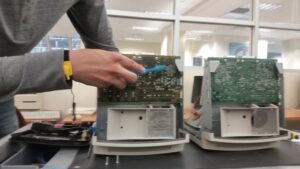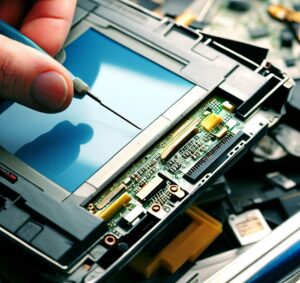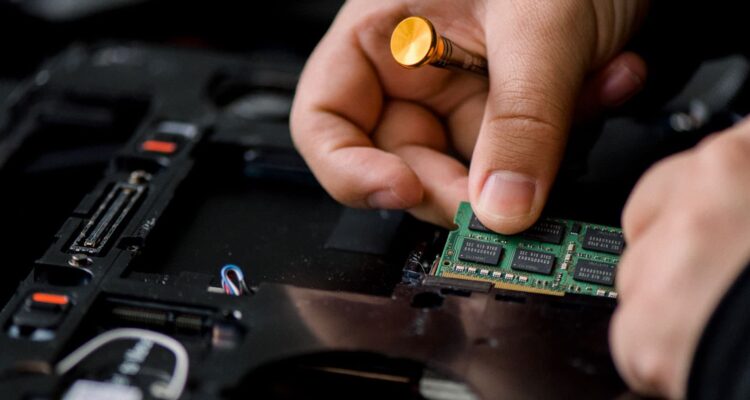In the rapidly evolving world of technology, the nostalgia and charm of retro computing devices continue to captivate enthusiasts and collectors alike. These vintage devices, ranging from classic home computers to arcade machines and game consoles, hold a special place in the hearts of those who remember the golden age of computing. However, as time marches on, these aging marvels are susceptible to wear and tear, making retro computing device repair an essential aspect of preserving our technological heritage. In this article, we will explore the significance of repairing retro computing devices, the challenges involved, and the measures taken by enthusiasts and professionals to ensure these pieces of history continue to shine.
Understanding the Significance of Retro Computing Devices

Retro computing devices, dating back to the 1970s and 1980s, paved the way for modern computing. They laid the foundation for today’s technological advancements, and understanding their roots is vital for tech enthusiasts and historians. These devices provided valuable insights into the history of software development, hardware engineering, and user interface design. They also represent the ingenuity of their time, showcasing how engineers and developers worked with limited resources to create groundbreaking innovations.
Challenges in Retro Computing Device Repair

Repairing vintage computing devices is no easy feat. Unlike modern devices, retro systems were built using older technologies, some of which are no longer in production. Finding replacement parts can be a significant challenge, often requiring enthusiasts to scour online auctions, thrift stores, and specialized forums. Additionally, many of the schematics and documentation for these devices have been lost or are difficult to access, further complicating the repair process.
Moreover, as these devices age, they become susceptible to component degradation and physical damage. Dust accumulation, rust, and corrosion can wreak havoc on internal circuitry, necessitating thorough cleaning and restoration. Battery leakage is a common issue in many retro devices, leading to severe damage to PCBs and traces. Repairing these damages demands expertise and patience.
Preserving the Past: Passionate Enthusiasts and Professionals

Despite the challenges, a thriving community of retro computing enthusiasts and professionals is dedicated to preserving these devices for future generations. Their passion for vintage technology fuels the repair and restoration efforts, ensuring that these computing relics remain functional and authentic.
- Expertise in Retro Repair: Many retro computing enthusiasts have spent years acquiring specialized knowledge about various vintage systems. They possess the skills to diagnose issues and identify creative solutions when replacement parts are unavailable. Their ability to reverse-engineer circuits and repair complex issues showcases their commitment to keeping these devices alive.
- Online Communities and Resources: The internet has become a hub for retro computing enthusiasts to collaborate, share knowledge, and seek help. Online forums and social media groups provide a platform for enthusiasts to discuss repair techniques, restoration projects, and share success stories.
- Retro Repair Services: Beyond the enthusiast community, professional repair services also play a crucial role in preserving retro computing devices. These specialized repair shops employ technicians with experience in handling vintage equipment. They often have access to a vast network of suppliers and resources to procure rare parts.
- 3D Printing and Reproduction: In situations where original components are no longer available, 3D printing technology has proven to be a game-changer. Enthusiasts and professionals can design and print custom replacement parts, ensuring the longevity of these vintage devices.
Retro computing device repair is a labor of love, where passion and dedication converge to preserve the technological heritage of the past. The efforts of enthusiasts and professionals ensure that these vintage devices continue to function and amaze, sparking nostalgia in those who fondly remember their introduction to the world of computing.
As technology continues to advance at an unprecedented pace, the significance of retro computing devices remains unparalleled. These devices are not only a testament to the ingenuity of their time but also a window into the roots of modern computing. By actively engaging in repair and restoration, we can bridge the gap between the past and the present, allowing future generations to experience the wonder of retro computing. So, the next time you stumble upon a dusty old IBM PC 110, HP 100LX, Psion Revo, Commodore 64 or an Atari 2600, remember that behind its worn exterior lies the potential to revive a piece of history.

